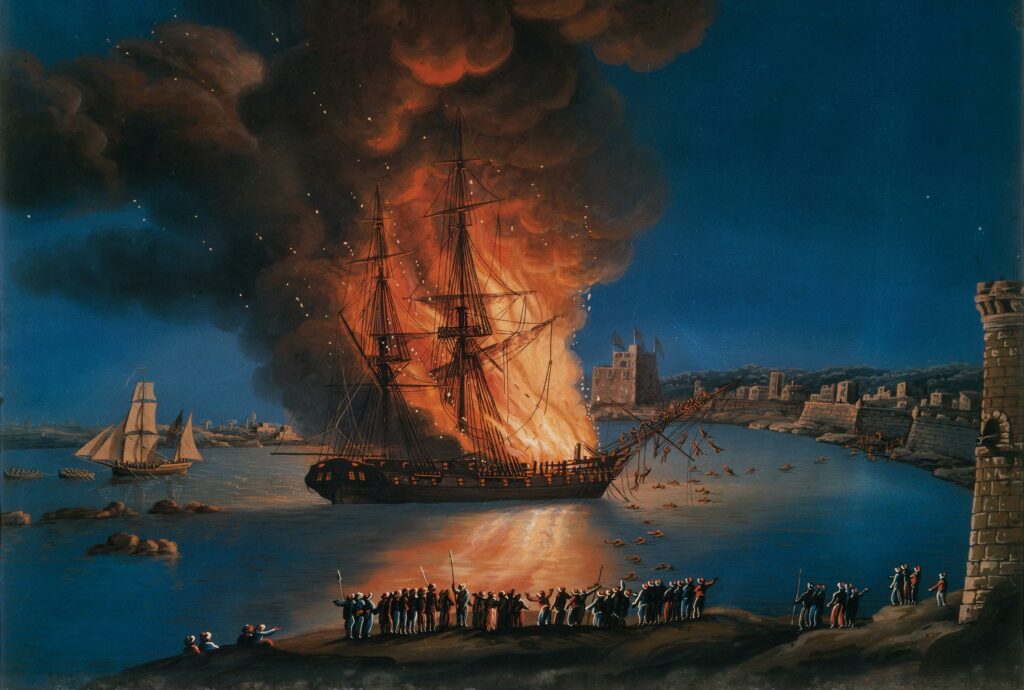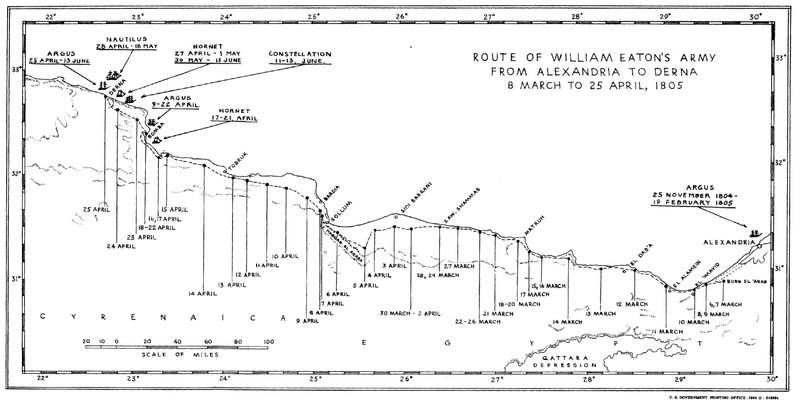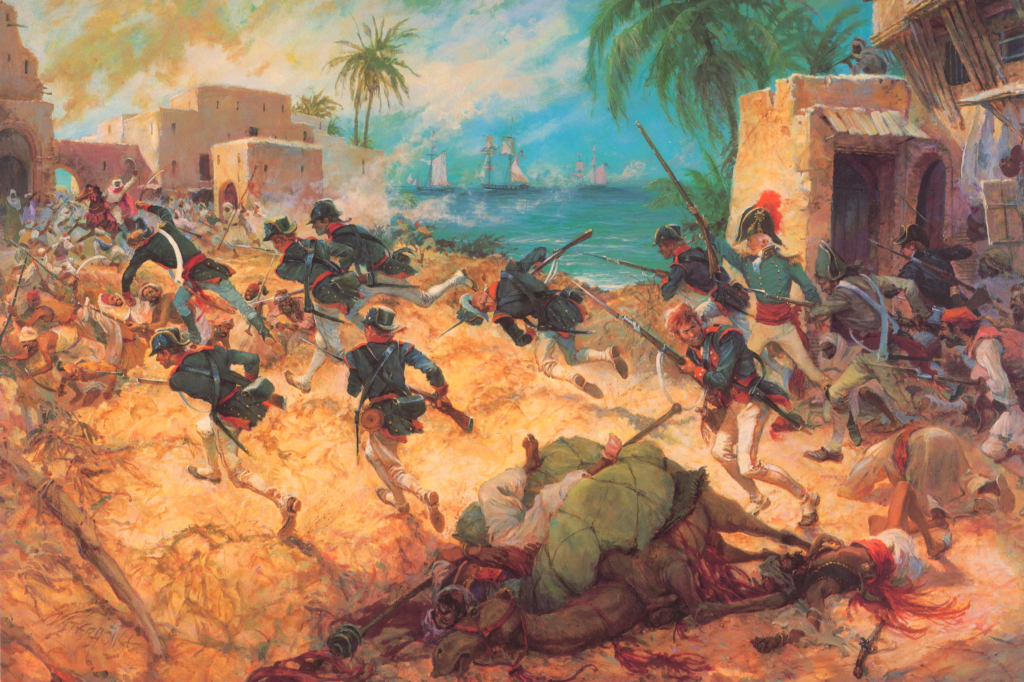The second line of the Marine Corps Hymn mentions “the shores of Tripoli,” today the capital and main city of Libya. What does this far-off place have to do with the United States Marines?
These famous words refer to the bold raid of April 27, 1805, led by First Lieutenant Presley Neville O’Bannon during the First Barbary War. This courageous move against a Barbary fortress city brought glorious victory to the United States. It was also the first occasion when U.S. forces hoisted the American flag (which included only 15 stars and stripes at that time) outside U.S. borders.
The First Barbary War: How It Started
The First Barbary War, which took place between 1801 and 1805, was the first war the United States fought overseas. Together with Sweden, its ally, the United States stood against the Barbary states of Algiers, Tripoli, Morocco, and Tunis.
At that time, Barbary pirates were the terror of the Mediterranean. North African pirate ships would constantly attack U.S. vessels. The pirates used to steal cargo, capture American seamen for ransom, and charge passage fees.
For a long time, the United States kept peace by paying tribute, but Tripoli took a more aggressive line against the U.S. On May 14, 1801, Yusuf Karamanli, the ruler of Tripoli, gave the order to cut the flagstaff next to the American consulate. This symbolic act led to a formal declaration of the First Barbary War, a.k.a. the Tripolitan War.
Capture of the USS Philadelphia
President Thomas Jefferson decided to put an end to the aggression of Tripoli’s corsairs. He ordered the Navy and the Marine Corps to take charge of the Mediterranean and sent war vessels to the area.

An unlucky storm caused the USS Philadelphia to suffer a wreckage near the shores of Tripoli. The local forces then captured the ship’s entire crew and imprisoned the men. Neither copious bombardments nor an offer of ransom could make the Pasha release the captives.
Eaton’s Proposal
Following these events, Lieutenant William Eaton, a Navy agent and formerly the consul in Tunis, suggested an alternative plan. He proposed forming a pact with Hamet Karamanli, Tripoli’s deposed pasha and Yusuf Karamanli’s brother. Hamet Karamanli aspired to take back the throne from Yusuf, a ruthless usurper who ascended to the throne by assassinating his elder brother.
In 1804, Thomas Jefferson gave Lieutenant William Eaton permission to back Hamet Karamanli in his claim to regain rule from his brother Yusuf. Eaton traveled to meet Hamet Karamanli in Egypt, where the latter was in exile, and proposed to help restore him to the throne. Karamanli accepted the offer.
Who would President Jefferson choose to lead the charge? The United States Marines, having written the book on Small Wars, were the perfect choice.
The March on Derna
On March 6, 1805, Lieutenant Eaton and a handful of Marines under the command of First Lieutenant Presley O’Bannon led a force of about four hundred Turkish, Arab, and Greek mercenaries. The expedition covered a 500-mile desert route between Alexandria, Egypt, and the port city of Derna, then the capital of the Ottoman Cyrenaica (today a region in East Libya).
It wasn’t an easy march. The provisions dwindled, and several mutiny attempts threatened the expedition. Finally, Eaton’s forces reached Bomba, a port city near Derna, where Eaton met the U.S. Navy warships Nautilus, Argus, and Hornet under the command of Captain Hull and Commodore Barron. The expedition was then able to restock its supplies and prepare for action in Derna.

The Battle of Derna
On April 26, Eaton wrote to Derna’s ruler, Mustafa Bey, to request safe passage through the city. Mustafa Bey refused. On the same day, Lieutenant Eaton’s forces stormed the city.
The battle of Derna took place on three fronts. Captain Hull’s vessels attacked from the sea and opened fire on the city’s batteries. At the same time, Eaton’s forces moved in two directions. The Arab mercenaries, under the leadership of Hamet Karamanli, were to cut off the route to Tripoli and storm the governor’s palace. Meanwhile, the Marines and the remaining mercenaries targeted the harbor.
The attack, which began around 2:45 p.m., was swift and successful. The city’s defenders hurried to flee, leaving their loaded cannons behind. At that historical moment, Lieutenant O’Bannon raised the stars-and-stripes flag over the captured battery. By 4 p.m., Eaton took full control of Derna and its 4,000 guards. The U.S. forces only suffered a handful of losses.

The Battle of Derna by Colonel Charles Waterhouse, USMCR
A Truce With Yusuf Karamanli
Yusuf Karamanli, located in Tripoli to the west, directed reinforcements to Derna. However, by the time Karamanli’s troops arrived, the U.S. forces had already conquered the city. The Tripolitans made several unsuccessful attempts to recapture Derna.
Meanwhile, Eaton planned to move further west and launch a land attack on Tripoli. However, in the middle of his march, he received orders to cease military action and return to Egypt following a treaty signed by the U.S. Department of State with Yusuf Karamanli.
The Legacy of the Battle of Derna
The Battle of Derna was a milestone for the United States armed forces. It was the first land battle the U.S. fought on foreign soil since the American Revolutionary War and the first time an American flag flew after a victory across the Atlantic. The lightning-fast action in Derna inspired the well-known line “to the shores of Tripoli” in the Marines’ Hymn.
The Tripolitan treaty that followed the Battle of Derna included the move of releasing the American prisoners of war for ransom. However, this didn’t end the Barbary Wars. The state-sanctioned piracy went on, with continued attacks on American vessels and the capture of prisoners.
Following more decisive action by the U.S. Navy in 1815, the United States defeated Algeria and signed a treaty that secured peace for U.S. vessels. The 1830 French conquest of Algeria was the final nail in the coffin of Barbary piracy.
Immortalize Special Moments With Embleholics’ Challenge Coins
As a service member or a veteran, maybe you’ve experienced your own “shores of Tripoli” moment, perhaps not as historically significant but meaningful to you and your unit. Custom challenge coins are a lovely and meaningful way to commemorate such milestones.
At Embleholics, we help you create stunning, individually designed coins that symbolize your service, your unit’s values, or a special event. Get in touch with us for a free quote.
FAQ
What are custom challenge coins?
Custom challenge coins are small coins or medallions with a unique design. Service members often give or receive these meaningful tokens on recruitment, after some pivotal experience, or at the end of their service. A challenge coin is a wonderful gift for military personnel, law enforcement officers, firefighters, and other service members.
How do I design a challenge coin?
First, you’ll let us know what you want your challenge coin to look like. If you only have a general concept, we’ll propose individual designs until we come up with something you like. Once you approve the design, we’ll provide a custom quote.
How soon will my coins ship?
Your shipment will arrive at your chosen address within 30 days from the time we start manufacturing your coins.
Do you also make other commemorative products?
Yes. We also create custom-designed lapel pins, belt buckles, and other products. Check out our gallery of past challenge coins to gain inspiration for your keepsake.

